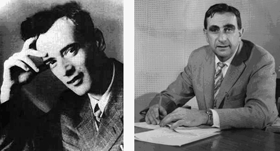70 years of Landau–Teller theory for collisional energy transfer. Semiclassical three-dimensional generalizations of the classical collinear model
Abstract
This article, in historical retrospective, describes the development of the celebrated Landau–Teller (LT) model of 1936 for vibrational-translational energy exchange in collisions of an atom with a diatomic molecule. We discuss semiclassical generalizations of the classical LT model and generalizations of the collinear LT model to account for the effects of rotation of the diatom on the vibrational relaxation rate. The former is based on the recovery of the Landau semiclassical exponent from the classical LT encounter time, and the latter on the definition of a 1-D driving mode within the manifold of the translational and rotational degrees of freedom of the colliding partners. The utility of generalized LT models is illustrated by three case studies that exemplify weak and strong effects of the rotation as well as the efficiencies of different driving modes in the vibrational relaxation of highly asymmetric diatoms.


 Please wait while we load your content...
Please wait while we load your content...